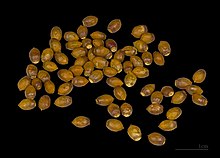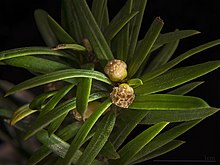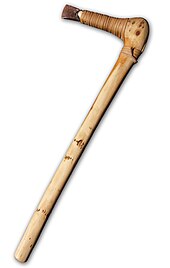Taxus
| Taxus Temporal range:
| |
|---|---|

| |
| Taxus baccata (European yew) shoot with mature and immature cones | |
| Scientific classification | |
| Kingdom: | Plantae |
| Clade: | Tracheophytes |
| (unranked): | Gymnosperms |
| Division: | Pinophyta |
| Class: | Pinopsida |
| Order: | Pinales |
| Family: | Taxaceae |
| Genus: | Taxus L. |
| Species | |
|
See text | |
Taxus is a genus of coniferous trees or shrubs known as yews in the family Taxaceae. They are relatively slow-growing and can be very long-lived, and reach heights of 2.5–20 metres (8.2–65.6 ft), with trunk girth averaging 5 metres (16 ft).[1] They have reddish bark, lanceolate, flat, dark-green leaves 10–40 millimetres (1⁄2–1+1⁄2 in) long and 2–3 mm (3⁄32–1⁄8 inch) broad, arranged spirally on the stem, but with the leaf bases twisted to align the leaves in two flat rows either side of the stem.[2] The oldest known fossil species are from the Early Cretaceous.[3]
Morphology[]

The seed cones are highly modified, each cone containing a single seed 4–7 mm (5⁄32–9⁄32 inch) long partly surrounded by a modified scale which develops into a soft, bright red berry-like structure called an aril, 8–15 mm (5⁄16–19⁄32 inch) long and wide and open at the end. The arils are mature 6–9 months after pollination, and with the seed contained are eaten by thrushes, waxwings and other birds, which disperse the hard seeds undamaged in their droppings; maturation of the arils is spread over 2–3 months, increasing the chances of successful seed dispersal. The male cones are globose, 3–6 mm (1⁄8–1⁄4 inch) across, and shed their pollen in early spring. Yews are mostly dioecious, but occasional individuals can be variably monoecious, or change sex with time.[2]
Taxonomy[]
All of the yews are very closely related to each other, and some botanists treat them all as subspecies or varieties of just one widespread species; under this treatment, the species name used is Taxus baccata, the first yew described scientifically.[4] Other sources, however, recognize 9 species, for example the Plant List.
Taxus species appear similar. Attempts at taxonomy vary from describing all yews as subspecies of T. baccata, as did RKF Pilger in 1903, to splitting species by even very small morphological differences, as did R. W. Spjut in 2007 with 25 species and over 50 varieties. Some species have traditionally been recognized by geographic distribution, but Asian species have been more difficult to classify. T. contorta in the Western Himalaya and T. sumatrana in Malesia are now generally agreed upon, but overlapping ranges in the Eastern Himalaya, China, and subtropical southeast Asia have led to greater confusion, with the species T. chinensis, T. mairei, and T. wallichiana being elucidated only in the 21st century with the aid of molecular phylogenetics.[5]

The most distinct is the Sumatran yew (T. sumatrana, native to Sumatra and Celebes north to southernmost China), distinguished by its sparse, sickle-shaped yellow-green leaves. The Mexican yew (T. globosa, native to eastern Mexico south to Honduras) is also relatively distinct with foliage intermediate between Sumatran yew and the other species. The Florida yew, Mexican yew and Pacific yew are all rare species listed as threatened or endangered.
Toxicity[]
All species of yew contain highly poisonous taxine alkaloids, with some variation in the exact formula of the alkaloid between the species. All parts of the tree except the arils contain the alkaloid. The arils are edible and sweet, but the seed is dangerously poisonous; unlike birds, the human stomach can break down the seed coat and release the toxins into the body. This can have fatal results if yew 'berries' are eaten without removing the seeds first. Grazing animals, particularly cattle and horses, are also sometimes found dead near yew trees after eating the leaves, though deer are able to break down the poisons and will eat yew foliage freely. In the wild, deer browsing of yews is often so extensive that wild yew trees are commonly restricted to cliffs and other steep slopes inaccessible to deer. The foliage is also eaten by the larvae of some Lepidopteran insects including the moth willow beauty.

Distribution[]
Yews occur around the globe in temperate zones of the northern hemisphere, northernmost in Norway and southernmost in the South Celebes. Some populations exist in tropical highlands. Yews typically occur in the understory or canopy of moist temperate or tropical mountain forests. Elevation varies by latitude from 3,000 metres (9,800 ft) in tropical forests to near sea level in its northernmost populations.[5] Yews are common in landscape architecture, giving rise to widespread naturalized populations in the United States. There, both T. baccata and T. cuspidata are common ornamental shrubs.[6]
T. baccata appears throughout Europe and into western Asia.[5] T. cuspidata occurs over much of East Asia, in China, Japan, Korea, and Sakhalin.[7] T. brevifolia ranges in the United States from California to Montana and Alaska,[6] while T. canadensis appears in the northeastern United States and southeast Canada.[5]
Allergenic potential[]
All parts of a yew plant are toxic to humans with the exception of the yew berries (however, their seeds are toxic); additionally, male and dioecious yews in this genus release cytotoxic pollen, which can cause headaches, lethargy, aching joints, itching, and skin rashes; it is also a trigger for asthma. These pollen granules are extremely small, and can easily pass through window screens. Male yews bloom and release abundant amounts of pollen in the spring; completely female yews only trap pollen while producing none.[8]
Yews in this genus are primarily separate-sexed, and males are extremely allergenic, with an OPALS allergy scale rating of 10 out of 10. Completely female yews have an OPALS rating of 1, and are considered "allergy-fighting".[8]
Uses and traditions[]

Bows[]
Yew wood is reddish brown (with whiter sapwood), and is very springy. It was traditionally used to make bows, especially the longbow.
Latin taxus "yew tree," is probably borrowed, via Greek, from Taxša, the Scythian word for yew (and bow)[9] (cognate of Persian تخش Taxš, meaning bow).[10][11]
British yews tend to be too gnarly, and thus the wood for English longbows used at the Battle of Agincourt was imported from Spain or northern Italy.[12] Ötzi, the Chalcolithic mummy found in 1991 in the Italian Alps, carried an unfinished bow made of yew wood. Consequently, it is not surprising that in Norse mythology, the abode of the god of the bow, Ullr, had the name Ydalir (Yew Dales). Most longbow wood used in northern Europe was imported from Iberia, where climatic conditions are better for growing the knot-free yew wood required.[13] The yew longbow was the critical weapon used by the English in the defeat of the French cavalry at the Battle of Agincourt, 1415.
Cultivation[]
It is suggested that English parishes were required to grow yews and, because of the trees' toxic properties, they were grown in the only commonly enclosed area of a village – the churchyard.[14] The yew tree can often be found in church graveyards and is symbolic of sadness. Such a representation appears in Lord Alfred Tennyson's poem "In Memoriam A.H.H." (2.61–64).
The yew can be very long-lived. The Fortingall Yew has been considered to be the oldest tree in Europe, at something over 2,000 years old. Tradition has it that Pontius Pilate slept under it while on duty before 30 AD. This has been topped by a tree in the churchyard of a small Welsh village called St Cynog. It has been dated to 5,000 years old by dendrologist Janis Fry.[15] Such old trees usually consist of a circular ring of growths of yew, since their heart has long since rotted away.
The Eihwaz rune is named after the yew, and sometimes also associated with the "evergreen" world tree, Yggdrasil.
Horticulture[]

Yews are widely used in landscaping and ornamental horticulture. Over 400 cultivars of yews have been named, the vast majority of these being derived from European yew (Taxus baccata) or Japanese yew (Taxus cuspidata). The hybrid between these two species is Taxus × media. A popular fastigiate selection of the European yew (Taxus baccata 'Fastigiata') is often called the Irish yew, illustrating the difficulties with common names. A few cultivars with yellow leaves are collectively known as golden yews.
Chemistry[]
The Pacific yew (Taxus brevifolia), native to the Pacific Northwest of North America, and the Canada yew (Taxus canadensis) were the initial sources of paclitaxel or Taxol, a chemotherapeutic drug used in breast and lung cancer treatment and, more recently, in the production of the Taxus drug eluting stent by Boston Scientific. Over-harvesting of the Pacific yew for paclitaxel led to fears that it would become an endangered species, since the drug was extracted from the bark of the yew, the harvesting of which kills the tree in the process.[16] However, methods were developed to produce the drug semi-synthetically from cultivated yews, without the need to further endanger the wild populations, and the Pacific yew is no longer at risk.[17] The more common Canada yew is also being successfully harvested in northern Ontario, Quebec and New Brunswick, and has become another major source of paclitaxel. Other yew species contain similar compounds with similar biochemical activity. Docetaxel, an analogue of paclitaxel, is derived from the European yew (Taxus baccata).

On January 18, 2008, the Botanic Gardens Conservation International (representing botanic gardens in 120 countries) stated that "400 medicinal plants are at risk of extinction, from over-collection and deforestation, threatening the discovery of future cures for disease." These included yew trees, whose bark is used for the cancer drug paclitaxel.[18][19]
In culture[]
The yew tree is a frequent symbol in the Christian poetry of T. S. Eliot, especially his Four Quartets.
Species and hybrids[]

Names not linked have been mentioned in publications but not yet validated according to the International Code of Botanical Nomenclature
- Species Group: Baccata Group
- Alliance: Baccata Alliance
- Taxus baccata European yew
- Taxus contorta West Himalayan yew
- Irish yew
- Taxus fuana, possible synonym of T. contorta
- English yew. synonym of Taxus baccata[20]
- Alliance: Cuspidata Alliance
- Delicate branch yew
- Caespitosa yew
- Taxus canadensis Canada yew
- Taxus cuspidata Rigid branch yew, Japanese yew
- Umbrelliform yew
- Alliance: Baccata Alliance
- Species Group: Sumatrana Group
- Taxus celebica Celebes yew
- Taxus kingstonii Kingston yew
- Maire yew
- Taxus sumatrana Sumatera yew
- Species Group: Wallichiana Group
- Subgroup: Chinensis Subgroup
- Asian limestone yew
- Taxus chinensis China yew
- Obscure yew
- Scaly yew
- Phyton yew
- Rehder yew
- Scutaceous yew
- Subgroup: Wallichiana Subgroup
- Taxus brevifolia Pacific yew, western yew
- Taxus floridana Florida yew
- Florin yew
- Taxus globosa Mesoamerican yew
- Suffness yew
- Taxus wallichiana Wallich yew, East Himalayan yew
- Subgroup: Chinensis Subgroup
Fossil (extinct) species
- † – Oligocene, Bohemia, twig-leaves, similar to T. mairei[21][22]
- † – Upper Miocene, leaf, similar to T. baccata[23]
- †Taxus masonii – Eocene Clarno Formation; Oregon, USA[24]
- † – Miocene, northern Idaho[22]
Commonly reported hybrids
Taxus × media = Taxus baccata × Taxus cuspidata[25]
= Taxus cuspidata × Taxus canadensis[26]
References[]
- ^ Moir, Andy (2013). "The exceptional yew trees of England, Scotland and Wales". Quarterly Journal of Forestry. 2013 (2013): 187. Retrieved 19 July 2014.
- ^ a b Hils, Matthew H. (1993). "Taxus". In Flora of North America Editorial Committee (ed.). Flora of North America North of Mexico (FNA). Vol. 2. New York and Oxford – via eFloras.org, Missouri Botanical Garden, St. Louis, MO & Harvard University Herbaria, Cambridge, MA.
- ^ Xu, Xiao-Hui; Sun, Bai-Nian; Yan, De-Fei; Wang, Jin; Dong, Chong (May 2015). "A Taxus leafy branch with attached ovules from the Lower Cretaceous of Inner Mongolia, North China". Cretaceous Research. 54: 266–282. doi:10.1016/j.cretres.2014.12.014. ISSN 0195-6671.
- ^ "Caroli Linnaei ... Species plantarum". Botanicus.org. Retrieved 2016-11-17.
- ^ a b c d Earle, Christopher J. (2020-05-19). "Taxus (yew) description". The Gymnosperm Database. Retrieved 2021-10-16.
{{cite web}}: CS1 maint: url-status (link) - ^ a b Garland, Tam; Barr, A. Catherine (1998). Toxic plants and other natural toxicants. International Symposium on Poisonous Plants (5th : 1997 : Texas). Wallingford, England: CAB International. ISBN 0851992633. OCLC 39013798.
- ^ Katsuki, T & Luscombe, D (2013). "Taxus cuspidata". The IUCN Red List of Threatened Species. 2013: e.T42549A2987373. doi:10.2305/IUCN.UK.2013-1.RLTS.T42549A2987373.en. Retrieved 16 October 2021.
- ^ a b Ogren, Thomas (2015). The Allergy-Fighting Garden. Berkeley, CA: Ten Speed Press. p. 205. ISBN 978-1-60774-491-7.
- ^ "Taxine | Origin And Meaning Of Taxine By Online Etymology Dictionary". 2019. Etymonline.Com. Accessed January 18, 2019. [1].
- ^ Mallory, J.P., and D.Q. Adams. 1997. Encyclopedia of Indo-European culture. London [etc.]: Fitzroy Dearborn. P.78.
- ^ Dehk̲h̲udā: Lughat-Nāma. Entry تخش.
- ^ Eichhorn, Markus (September 2010). "Yew – The Sacred Tree". Test Tube. Brady Haran for the University of Nottingham.
- ^ "Yews in Spain". www.iberianature.com. Retrieved 2 April 2018.
- ^ "YEW TREES IN CHURCHYARDS". Sacred-texts.com. Retrieved 8 August 2011.
- ^ David Sanderson (2014-07-08). "Bronze Age tree survives wars (and the builders) to be claimed as Britain's oldest". The Times. Retrieved 2016-11-17.
- ^ Gersmann, Hanna; Aldred, Jessica (10 November 2011). "Medicinal tree used in chemotherapy drug faces extinction". The Guardian. Retrieved 2017-02-15.
- ^ "Rare, Threatened and Endangered Species of Oregon. Institute for Natural Resources" (PDF). Portland State University, Portland, Oregon: Oregon Biodiversity Information Center. 2010. Archived from the original (PDF) on 2011-01-28.
- ^ "Medical plants 'face extinction'". BBC NEWS. 19 January 2008.
- ^ "'Miracle' Cures Face Extinction". Botanic Gardens Conservation International. 16 January 2008.
- ^ "Taxus baccata L." www.worldfloraonline.org. Retrieved 2021-10-09.
- ^ Kvaček, Z. 1984. Tertiary taxads of NW Bohemia. 1982 Acta Univ. Carol., Geol., Pokorny 4: 471–491.
- ^ a b Spjut, R. W. (2007). "Taxonomy and nomenclature of Taxus (Taxaceae). A phytogeographical analysis of Taxus (Taxaceae) based on leaf anatomical characters". J. Bot. Res. Inst. Texas. 1 (1): 291–332. 203–289. T. brevifolia and T. globosa var. floridana thought to evolve from ancestral T. globosa by loss of stomata and papillae; T. canadensis recognized in Europe based on leaf fossils from late Tertiary deposits
- ^ Corneanu, G. C. , M. Corneanu and R. Bercu. 2004. Comparison between some morpho-anatomical features at fossil vegetal species and at their actual correspondent species. Studia Universitatis Babeş-Bolyai, Geologia, XLIX: 77–84.
- ^ Manchester, S.R. (1994). "Fruits and Seeds of the Middle Eocene Nut Beds Flora, Clarno Formation, Oregon". Palaeontographica Americana. 58: 30–31.
- ^ "Eibenhecken :-) Pflanzung, Schnitt, Sorten - Taxus baccata". Derkleinegarten.de. Retrieved 2016-11-17.
- ^ "Overview of the genus Taxus, Taxonomy, Nomenclature, and Ovulate Shoots". Worldbotanical.com. Retrieved 2016-11-17.
External links[]
- Taxus
- Conifer genera
- Dioecious plants